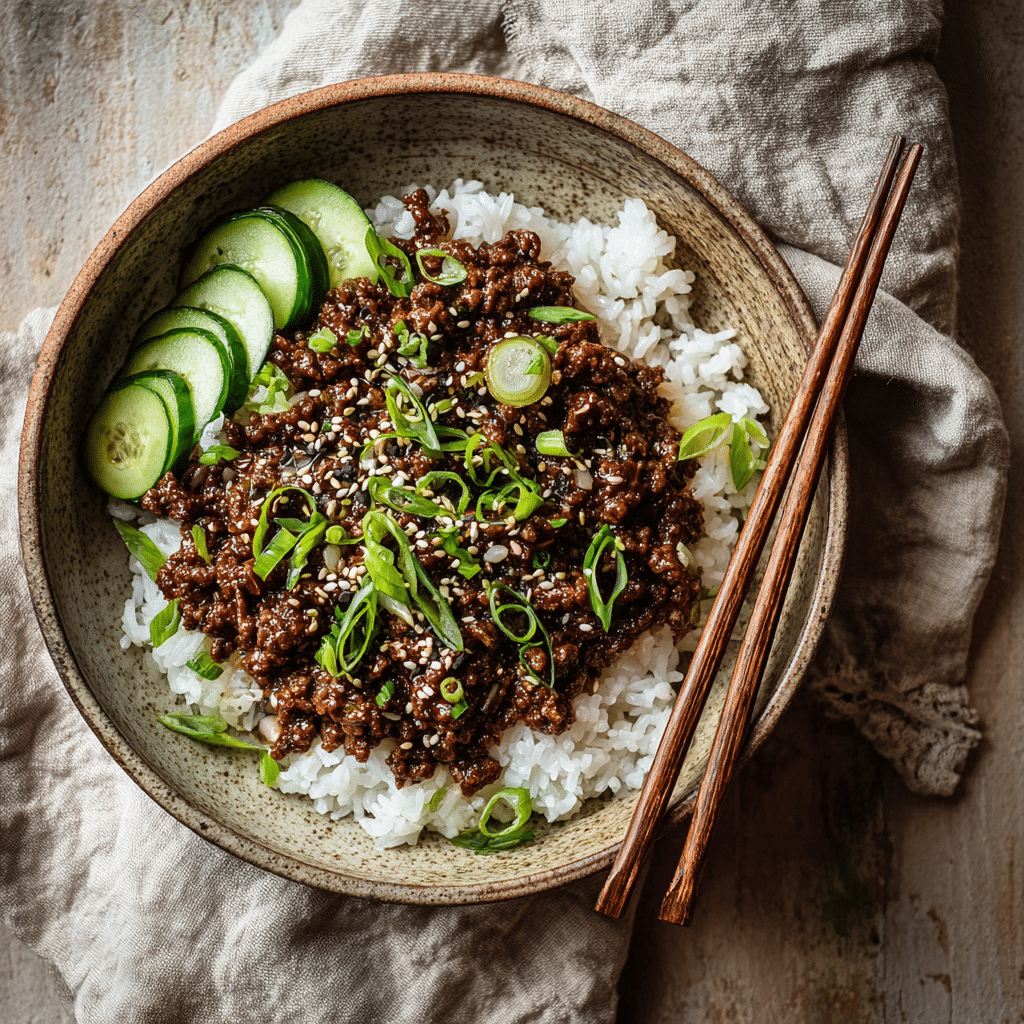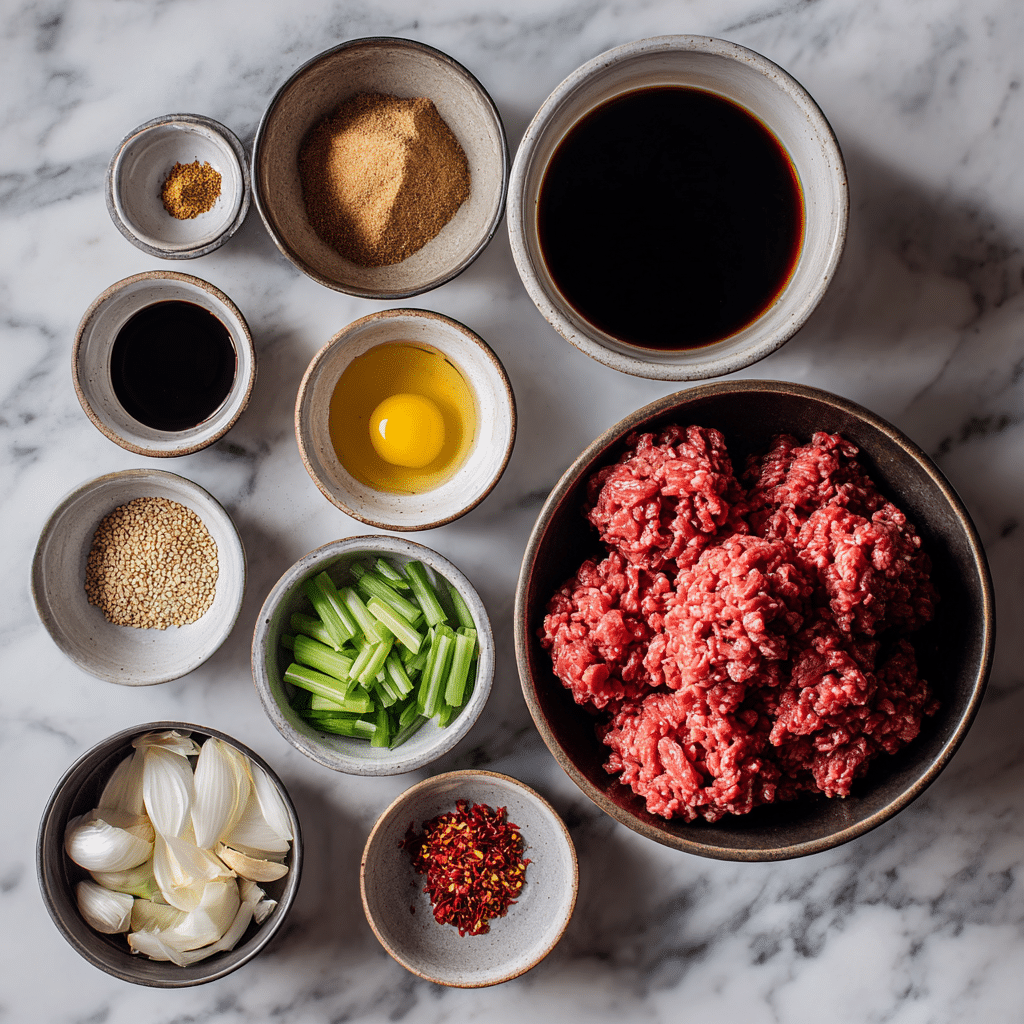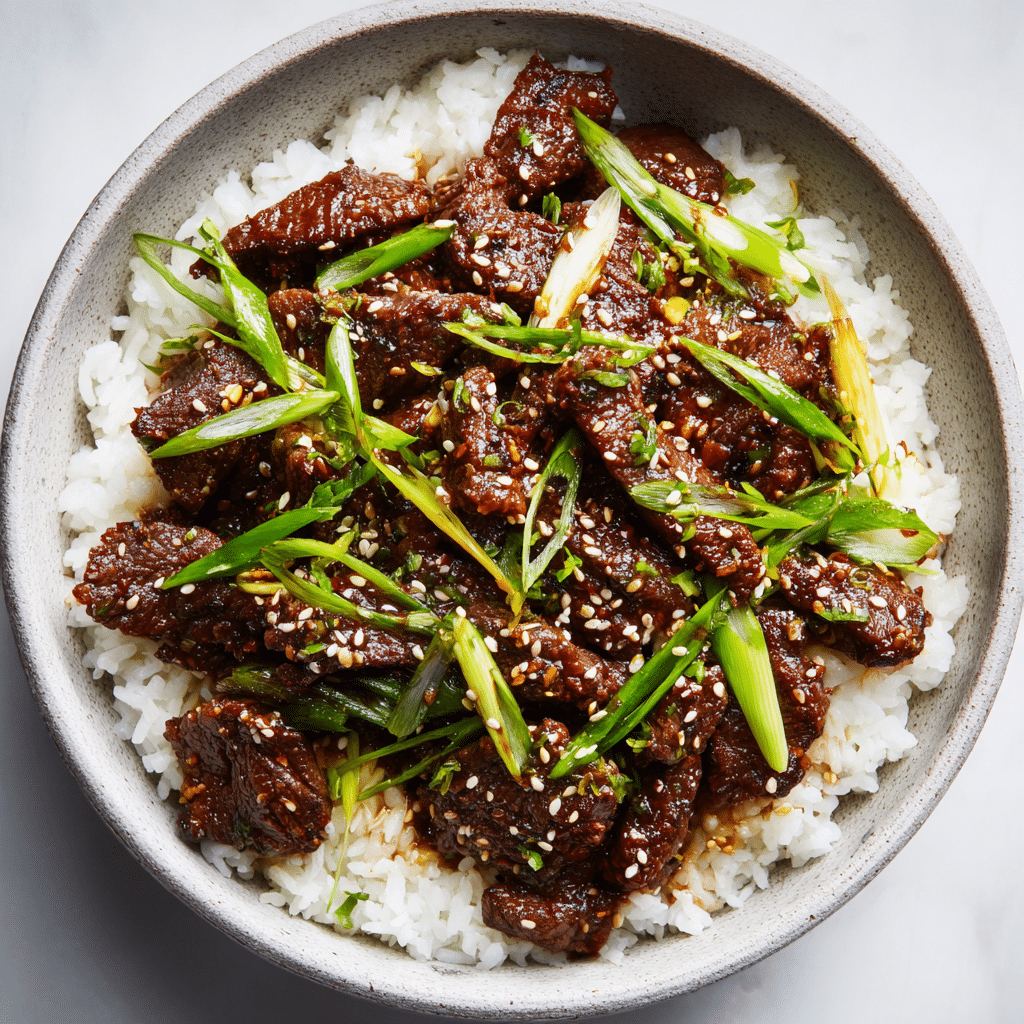Crave a fast korean beef recipe that hits sweet-salty-savory notes in minutes? You’re in the right kitchen. I fell for this bowl on a slammed Tuesday when I needed dinner, like, now. I browned beef, whisked a quick soy-garlic-ginger sauce, and boom over warm rice with scallions and sesame, it tasted like weeknight bulgogi.

Since then, I’ve fine-tuned the balance (reduced-sodium soy, a hint of brown sugar, a whisper of heat) and built in flexible swaps so you can use what you have. Keep reading and you’ll nail a korean beef recipe that’s fast, affordable, and wildly satisfying.
Why This Korean Beef Recipe Wins on Busy Nights
I learned to trust a korean beef recipe on nights when time and energy run low but cravings run high. Years ago, I tried a quick ground-beef take on bulgogi, and the magic stuck: brown beef hard and fast, then flood the pan with a glossy mix of reduced-sodium soy, brown sugar, garlic, ginger, and sesame oil. The sauce clings; the kitchen smells incredible; dinner lands in 15 minutes flat.
Because I cook for real life, I keep this korean beef recipe flexible. Want leaner bowls? Choose 90% lean beef and drain well. Need a gluten-aware option? Swap in coconut aminos and keep the flavor big. Crave heat? Add a shake of red pepper flakes or a little gochujang, then finish with scallions and sesame seeds for crunch and pop. Serve it over steamed rice, brown rice, or cauliflower rice and you’ve got a complete bowl with zero fuss. Yummy Korean beef recipe
Moreover, this korean beef recipe respects your pantry and your budget. The ingredient list stays short, yet the payoff tastes like you cooked all afternoon. Double the sauce if you’re a “saucy bowl” person; it’s a pro move that coats every grain of rice and keeps leftovers juicy for meal prep. When I plan a quick weeknight lineup, I pair these bowls with speedy sides, then save room for something chill like a high-protein dessert later. As you read on, I’ll show you the exact ingredients, smart swaps, and a simple method that guarantees consistent results so you can put a reliable korean beef recipe on repeat without getting bored.
When you want more quick dinners, explore our ground beef and rice recipes collection on Greatly Recipes, which pairs perfectly with these bowls, and circle back for a sweet finish with our cottage cheese chocolate mousse for a lighter dessert option after a savory bowl.
Ingredients & Smart Swaps for a Crowd-Pleaser

A great korean beef recipe starts with a short, reliable list. I keep the core matrix the same every time reduced-sodium soy sauce, brown sugar, garlic, ginger, and a touch of sesame oil because that combo nails sweet-salty balance fast, just like the popular ground-beef bulgogi bowls everyone loves. I use 80–90% lean beef for juicy results; then I add heat with red-pepper flakes or a spoon of gochujang when I want kick. Finish with scallions and sesame seeds for crunch and aroma.
However, flexibility keeps this korean beef recipe in the weeknight rotation. If you need a gluten-aware route, swap tamari or coconut aminos for soy. If you’re aiming lighter, ground turkey works; you just sear a minute longer to get good browning before saucing. For lower sugar, cut the brown sugar slightly and boost fresh ginger to maintain pop. Each tweak keeps the bowl bold and satisfying over white rice, brown rice, or cauliflower rice.
Because sides make the bowl, I often add quick veggies shredded carrots, mushrooms, or spinach right in the pan during the last minute. You can also serve it with kimchi or a fried egg to echo the flavors you see in speedy Korean-inspired bowls.
| Ingredient | Smart Swap (Why it Works) |
|---|---|
| Soy sauce (reduced-sodium) | Tamari or coconut aminos for gluten-aware or sweeter, mellow salinity. |
| Brown sugar | Less sugar + extra ginger for brightness; or honey for rounder sweetness. |
| Ground beef (80–90% lean) | Ground turkey ; keep high heat for browning before sauce. |
| Red-pepper flakes | Gochujang for deeper heat and subtle tang; start with 1–2 tsp. |
Plan to scale? Double the sauce so every grain of rice gets coated; it’s a small move that turns a simple korean beef recipe into a glossy, meal-prep-friendly bowl.
Step-by-Step: Sear, Sauce, Simmer
- Preheat a large skillet over medium-high heat until hot; this primes the pan for browning.
- Add ground beef; break it into fine crumbles with a firm spatula.
- Let the beef sit for 30–45 seconds between stirs so it browns, not steams; repeat until most pink fades.
- Tilt the pan; spoon off excess fat so the korean beef recipe tastes clean and balanced.
- Stir in minced garlic and grated ginger; cook 20–30 seconds until fragrant, stirring constantly.
- Whisk the sauce in a cup: reduced-sodium soy sauce, brown sugar, a drizzle of sesame oil, and either red-pepper flakes or 1–2 teaspoons gochujang for heat.
- Pour the sauce over the beef; immediately scrape up browned bits to enrich flavor.
- Simmer 1–2 minutes; watch the liquid gloss and lightly thicken so it coats each crumble.
- Prefer saucy bowls? Add 2–3 tablespoons water and a scant teaspoon extra brown sugar; simmer 30 seconds more.
- Kill the heat; fold in sliced scallions and sprinkle sesame seeds for crunch and aroma.
- Taste; tweak salt with a dash of soy, round sweetness with a pinch of sugar, or brighten with a squeeze of lime.
- Scoop the beef over hot white rice, brown rice, or cauliflower rice; spoon extra sauce from the pan on top.
- For quick veggies, stir in matchstick carrots, mushrooms, or spinach during the last minute; they wilt fast and add texture.
- Batch-cook nights? Double the sauce at the start so leftovers reheat juicy and glossy.
- Serve immediately; this korean beef recipe shines when hot and freshly garnished.
Bowls & Sides That Make It a Meal
Build a bowl that eats like dinner, not just a quick bite. Start with a base that suits your mood, then stack contrasting textures so every spoonful pops. I serve this korean beef recipe over fluffy white rice when I crave classic comfort. However, brown rice adds nuttiness and extra fiber. Cauliflower rice keeps things lighter while still soaking up the glossy sauce. Quinoa works, too; its tiny curls grab beef crumbles in a satisfying way. Next, add crunch and freshness. I toss in quick vegetables right in the skillet or on the side. Thin mushrooms bring savoriness. Shredded carrots add gentle sweetness. Baby spinach wilts in seconds and turns the bowl vibrant. You can also set out a “toppings bar” so everyone customizes. Scallions and sesame seeds give snap and aroma. A fried egg adds richness and turns the bowl into a full-on comfort plate. Even better, a spoon of kimchi brings tang and gentle heat that plays perfectly with the sweet-salty sauce. Now think about sides that fill the table without slowing you down. I like a simple cucumber salad with rice vinegar for cool relief. Roasted broccoli gives char and structure. Quick pickled radish adds a bright, peppery bite. Then, for a quick flavor duet, I drizzle a tiny line of toasted sesame oil on the finished bowl and finish with a few extra sesame seeds. Because balance matters, I also keep a squeeze of lime or a splash of rice vinegar handy. A small hit of acid wakes the sauce right before serving. Finally, remember variety across the week. Rotate bases and sides so this korean beef recipe never feels repetitive. One night it’s white rice with kimchi and a fried egg. Another night it’s cauliflower rice, roasted broccoli, and a cucumber salad. Small switches, big payoff.
| Bowl Base | Toppers & Sides (Why they work) |
|---|---|
| White rice | Scallions + sesame seeds for crunch; kimchi for tangy heat |
| Brown rice | Roasted broccoli adds char; cucumber salad cools each bite |
| Cauliflower rice | Spinach wilts fast; pickled radish brings brightness |
| Quinoa | Mushrooms boost umami; fried egg adds richness |
Make-Ahead, Meal Prep, and Storage
I make this korean beef recipe for weeknights and meal prep. You can cook once, then eat well for days without flavor fade. Start by doubling the sauce if you love glossy bowls; extra cling keeps rice moist after chilling. Right after cooking, cool the beef quickly. Spread it in a thin layer on a sheet pan for 10 minutes; then portion into airtight containers. Because steam turns into ice later, let the rice cool separately so grains stay fluffy.
For grab-and-go lunches, I build single-serve bowls. I spoon rice into one side and nest the beef on the other. Then I tuck a small container of scallions and sesame seeds in the same box so they stay crisp. If I want veggies mixed in, I fold in quick-wilt spinach or matchstick carrots during the last minute of cooking; they reheat tender and keep the bowl balanced.
When reheating, I re-gloss the skillet portion with a splash of water, then stir for 1–2 minutes over medium heat. That little moisture wakes the sauce without making the beef soggy. In the microwave, I drape a damp paper towel over the bowl and heat in 45-second bursts, stirring once for even warmth. If the bowl looks dry, I add a teaspoon of soy or a drizzle of sesame oil for sheen. For freezer nights, I pack flat, label clearly, and thaw overnight in the fridge so the texture stays close to fresh.
Because planning saves time, I map two quick variations for later in the week. One night I add gochujang and mushrooms for a deeper, savory bowl. Another night I finish with a fried egg and kimchi for a punchy, diner-style vibe. Small tweaks keep this korean beef recipe exciting while you stay on budget and schedule.
| Storage Step | Best Practice (Why it Works) |
|---|---|
| Fridge (3–4 days) | Cool fast, pack airtight, store rice and beef side-by-side for fresher texture. |
| Freezer (2–3 months) | Freeze flat in labeled bags; thaw overnight for best texture and flavor retention. |
| Reheat (skillet or microwave) | Add a splash of water; warm gently; finish with soy or sesame oil for gloss. |

Korean Beef Recipe: Fast, Flavor-Packed Weeknight Dinner
Ingredients
- 1 lb 450 g ground beef, 85–90% lean
- 3 tbsp reduced-sodium soy sauce or tamari
- 2 –3 tbsp brown sugar packed
- 2 cloves garlic minced
- 1 tsp fresh ginger finely grated
- 1 tsp toasted sesame oil
- ½ –1 tsp red-pepper flakes or 1–2 tsp gochujang
- 3 cups cooked rice white, brown, or cauliflower
- 3 scallions thinly sliced
- 1 tbsp sesame seeds
- Lime wedges or rice vinegar to taste (optional)
Instructions
- Preheat a large skillet over medium-high heat until hot.
- Add the beef; crumble and brown, letting it sit between stirs to develop fond.
- Spoon off excess fat, then stir in garlic and ginger for 20–30 seconds.
- Whisk soy, brown sugar, sesame oil, and chili (or gochujang); pour over beef and scrape up browned bits.
- Simmer 1–2 minutes until glossy and lightly thickened; add a splash of water if you like extra sauce.
- Kill the heat; fold in scallions and sesame. Taste and adjust salt, heat, and sweetness.
- Serve over hot rice; finish with more scallions, sesame, and a squeeze of lime or splash of rice vinegar.
Notes
- Make it lighter: use ground turkey; brown well before saucing.
- Gluten-aware: swap tamari or coconut aminos for soy.
- Meal prep: cool fast; refrigerate 3–4 days or freeze up to 3 months.
- Extra saucy: double the sauce; simmer 30 seconds after adding 2–3 tbsp water.
Nutrition
Variations & Heat Levels of Korean Beef Recipe

Keep this korean beef recipe exciting with simple switches that change the vibe without adding work. First, tune the heat. Red-pepper flakes give quick warmth with zero prep. Gochujang adds deeper, fermented spice and a subtle tang that feels cozy on cool nights. If you love citrus lift, finish with a squeeze of lime or a splash of rice vinegar right before serving; acid makes the sweet-salty sauce pop. For a smoky twist, bloom a pinch of smoked paprika in the hot fat for 10 seconds, then add the sauce; it whispers barbecue while staying weeknight-fast.
Next, play with the base and the veg. I fold in thinly sliced mushrooms for umami, shredded carrots for gentle sweetness, and baby spinach at the end so it wilts in seconds. Bell peppers add crunch; zucchini coins soften quickly and catch the glossy sauce. When I want a “takeout-at-home” feel, I spoon the beef over garlicky fried rice and crown it with a jammy fried egg. On lighter nights, I go cauliflower rice with a big handful of scallions and sesame seeds for texture.
Flavor boosters keep your rotation fresh. Toasted sesame oil already stars in the sauce, but a tiny extra drizzle at the end amplifies nuttiness. A teaspoon of brown sugar deepens caramel notes for saucy fans; a half-teaspoon of fresh ginger brightens everything when you trim sugar. If you enjoy crunch, shower bowls with roasted seaweed flakes or crushed roasted peanuts for a playful finish.
| Variation | How to Do It (Why it Works) |
|---|---|
| Spicy Gochujang | Stir in 1–2 tsp gochujang with the sauce; deeper heat and subtle tang. |
| Veggie-Loaded | Add mushrooms, carrots, and spinach in the last minute; bulk + color fast. |
| Egg-on-Top | Top bowls with a fried egg; richness turns a quick bowl into comfort food. |
| Extra Saucy | Double the sauce; add 2–3 Tbsp water and simmer 30 sec for glossy cling. |
FAQs
Is this korean beef recipe authentic bulgogi?
No. It borrows bulgogi flavors (soy, garlic, ginger, a touch of sweetness) but uses ground beef for speed. You still get that sweet-savory profile in 15 minutes.
How do I make this korean beef recipe spicier?
Stir in 1–2 teaspoons gochujang with the sauce or add extra red-pepper flakes. Taste, then adjust in small amounts so heat doesn’t overpower the balance.
Can I prep this korean beef recipe ahead?
Yes. Cook, cool fast, and pack airtight. It keeps 3–4 days in the fridge. Reheat with a splash of water on the stove or under a damp paper towel in the microwave.
What should I serve with korean beef recipe?
Spoon it over white rice, brown rice, or cauliflower rice. Add scallions and sesame seeds, then serve with kimchi or a quick cucumber salad for contrast.
Conclusion
This korean beef recipe proves that big flavor doesn’t need long prep. You brown the beef hard, whisk a quick soy–garlic–ginger sauce, and finish with scallions and sesame for crunch. Then you choose a base white rice for comfort, cauliflower rice for light, or quinoa for variety and add a speedy side like cucumber salad or roasted broccoli. Moreover, small tweaks keep it fresh all week: gochujang for heat, extra ginger for brightness, or a fried egg for richness. If you’re planning a menu, rotate bowls with ideas from our dinner hub while skimming our beef recipes for skillet-friendly variety; on busy nights, I even pair leftovers with ideas from our ground beef and rice recipes so the plan stays effortless. Yummy korean beef recipe.
For more recipes follow me in GreatlyRecipes PINTEREST
